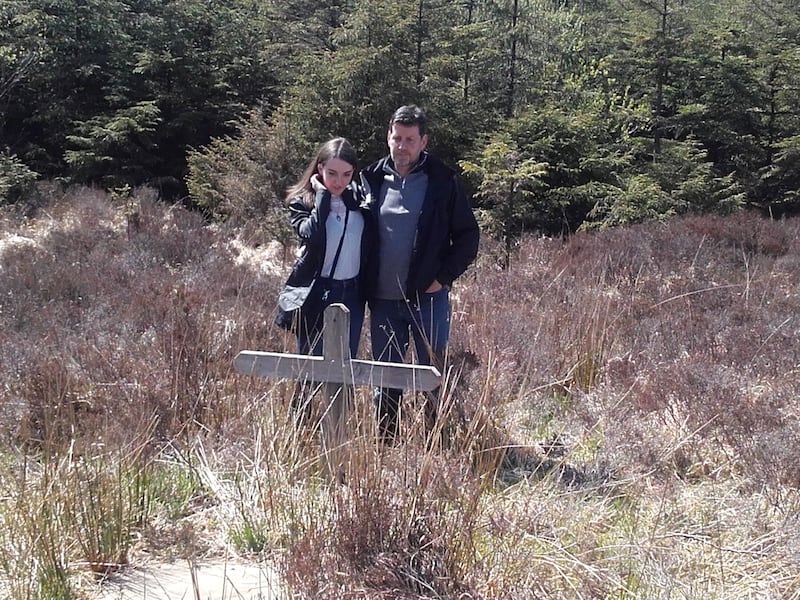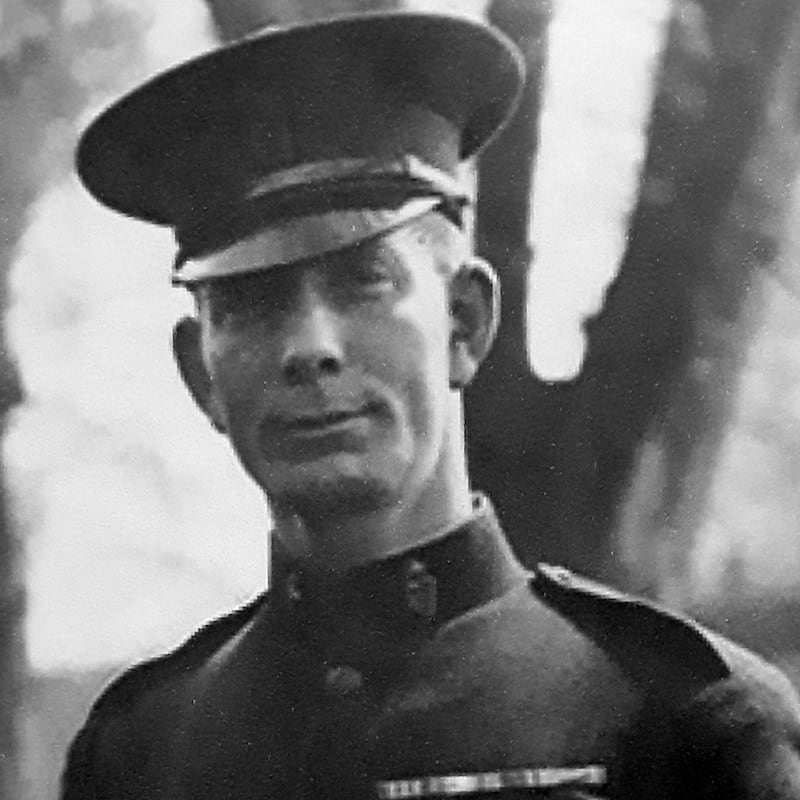“Will you write about the soldier in the bog?” That was the question I was repeatedly asked by locals in Miltown Malbay 15 years ago when I wrote my first book on the War of Independence in Clare. Local pharmacists, publicans and pensioners all told me a story about a British soldier who was captured by the IRA in 1921 whilst visiting his girlfriend. After being taken prisoner, he was executed and buried in a nearby bog.
After years of research I met PJ Donnelan, a local farmer who had far more detail on the story than anyone else. He led me to the exact spot in Drumbawn Bog where the soldier was thought to be buried. The tale was an intriguing one for any budding historian, but there were two problems with it. First, no one had any documentary evidence of the killing and, second, neither PJ nor anyone else knew the soldier’s name.
Knowing the Royal Scots Regiment had been stationed in the area I wrote to their regimental museum hoping to identify the soldier. They responded briefly, and I found the response unsatisfactory.
Then, in 2012 I discovered correspondence between the British Colonial Office and the Free State army which identified the soldier as Pte George Chalmers. I immediately phoned PJ and we decided to mark the gravesite with a simple slab which read: George Chalmers – British soldier – 11th June 1921.
READ MORE
I carved the slab myself and placed it on the site of Chalmers’ burial a few weeks later. It took four of us, including the grandson of one of Chalmers’ executioners, over an hour to carry the stone half a mile across the bog. I then wrote an article about the execution, which was published in History Ireland.
Six years later, Peter Chalmers, whose grandfather had been a cousin of Pte Chalmers, found this article online and contacted the Commonwealth War Graves Commission to have the body of his relative exhumed.
In May 2018 members of An Garda Síochána began a dig searching for Chalmers’ remains. Directly below the grave slab, at a depth of two feet, they discovered his remains. Little of his skeleton survived, except for a few bone fragments. However, his uniform was intact and the money he had carried was still in his pockets. The remains were taken to Dublin for reinterment at Grangegorman military cemetery.

At the invitation of the Chalmers family, I attended his funeral ceremony in October 2018. Afterwards I sat down with two members of the British ministry of defence’s Joint Casualty and Compassionate Centre and offered to identify the grave site of another British soldier – Pte George Robertson.
Robertson had been executed by the IRA and buried in Ballynoe Bog, Connolly, Co Clare, in October 1920. I also presented them with a list identifying the burial places of almost all of the British soldiers who had been disappeared by the IRA in the 1920s. The ministry of defence officials were shocked and somewhat embarrassed. They quickly suggested this was a matter for the Commonwealth War Graves Commission, who, in turn, were equally quick to pass the responsibility on to the gardaí.
I pursued the matter because I had a personal interest in doing so. A relative of mine, Ned Lynch, captain of the IRA’s Miltown Malbay Company, had ordered Robertson’s execution. I marked the spot of Robertson’s secret grave in Ballynoe Bog with another stone grave slab. Over the last seven years, I have appealed to various government authorities through the press, television and radio for the recovery of his remains. To date all of my appeals have been ignored.
The popular belief is that “The Disappeared” were a phenomenon linked to the Provisional IRA from the 1970s onwards. In fact, the overwhelming majority of those executed and buried in secret during the 20th century were killed by the so-called “good Old IRA”, who disappeared at least 115 people over the course of the War of Independence and Civil War. A century later, the bodies of at least 60 of those disappeared by the Old IRA are still missing.
I have discovered the burial places of more than a dozen people who were disappeared during that time. Pte Reginald Brown, a deserter from the British army, was executed after being held prisoner at a cottage near the village of Grenagh in Cork. One of his executioners stated that he buried the soldier “300 yards from the cottage”. I have located the cottage and spoken to the landowner, who identified the approximate location of the grave. Archaeological surveying techniques could easily uncover the exact burial place if the political will to do so existed.
Longford schoolteacher John McNamee, a suspected British spy, was drowned by the IRA in Lough Ree and buried by his executioners on the shoreline to the left of the pier at Barley Harbour.
Brian Bradley, a Catholic farmhand accused of being a British spy, was secretly executed by the IRA in January 1921 and buried at Rathmanoo Wood, a tiny copse near Moynalty in Meath, where his body remains.

RIC Constable Thomas Walsh was captured by the IRA, summarily executed and buried near a ringfort at Ringwood, Blarney. The land is due to be developed for a housing project, raising the possibility that an archaeological examination of the site in advance of building works could lead to the recovery of Walsh’s remains.
Michael Williams, a former RIC constable alleged to have been one of Tomás MacCurtain’s assassins, was executed in 1922 at the farm of Martin Corry, a local IRA officer and later a Fianna Fáil TD in Cork. According to an a contemporary report, “Williams was buried in the corner of the second field on the right hand side of a lane leading from the rear of Corry’s house at the corner nearest the house. A ‘spy’ was buried in the same corner a fortnight previous.”
I have visited the farm and the reported burial place of Williams is very easily identifiable. The alleged spy buried next to him was William Dalton, a Protestant loyalist from Cork who had previously served in the British Army.
While the establishment and work of the Independent Commission for the Location of Victims’ Remains has been a great success in finding the remains of those disappeared during the Troubles in Northern Ireland, there is clearly a lack of political will to make any effort to recover the bodies of those disappeared during the War of Independence era.
The British public seem largely ignorant of this aspect of their country’s history. Their government is unlikely to seek the recovery of British soldiers disappeared in the 1920s because it would raise awkward questions about their army’s history in Ireland, tarnishing the carefully crafted reputation of the noble, heroic ‘British Tommy’ of the first World War.
The legacy of the Troubles has ensured that the political establishment in Ireland is decidedly uncomfortable about the violence used to establish the modern Irish State. Recovering the bodies of the remaining disappeared from the 1916-23 period would risk damaging a key foundation myth of the Irish state – the romanticised notion of “the good Old IRA”.
Ireland is a signatory of the Geneva Convention, which in 1949 stipulated that a state must “endeavour to facilitate the return of the remains of the deceased upon request of the party to which they belong or upon the request of their next of kin”.
The State should work with relatives of those disappeared in the 1920s, as well as historians and archaeologists, to achieve this goal. That is of course unless it believes the disappeared of the War of Independence are somehow less deserving of a formal burial than those disappeared during the Troubles?
Pádraig Óg Ó Ruairc is the author of The Disappeared - Forced Disappearances in Ireland 1798-1998, published by Merrion Press
This piece was corrected on February 23rd as an incorrect photograph had been used in the original version.
- Sign up for push alerts and have the best news, analysis and comment delivered directly to your phone
- Find The Irish Times on WhatsApp and stay up to date
- Our In The News podcast is now published daily – Find the latest episode here










